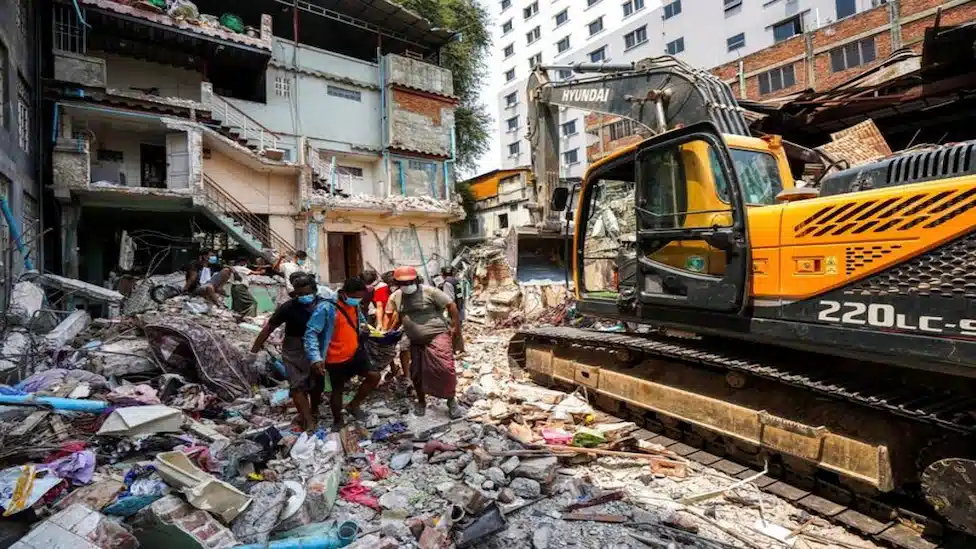Myanmar Earthquake Death Toll: In Myanmar, a massive 7.7-magnitude earthquake struck on March 30, 2025. The earthquake hit on Friday, leaving through-built destruction. As of Sunday, the death toll was around 1,700, with more than 3,400 injured.
More than 300 are still missing. As rescue efforts continue, the Myanmar earthquake death toll is expected to rise significantly. Foreign assistance has poured in, with countries from India to China to Thailand offering support, as the disaster has overwhelmed the country’s hospitals and rescue efforts.
The situation is critical, with many areas inaccessible because of damaged infrastructure.
Also Read | South Korea Wildfire Helicopter Crash: Pilot Killed in Uiseong Disaster
Myanmar Earthquake Death Toll: Insights
- The Myanmar earthquake death toll has now reached 1,700, with many more injured and missing.
- Hospitals are overwhelmed, and rescues are struggling.
- Help is coming from countries such as India, China, and Thailand.
- Bridges and airports are among Myanmar’s critical infrastructure, which causes extensive damage.
- The quake was felt across borders, with neighboring Thailand being affected.
- Resource availability for survivors is limited in some areas, and the situation is dire.
Background
Myanmar has been in turmoil since a military coup in 2021. The country’s infrastructure and health care system were already strained by internal conflict. Then came the recent earthquake, which only compounded the situation.
The country is already grappling with civil unrest and a weakening economy, while also facing the challenge of responding to a disaster. This international help is vital, but aid is trickling to places hit by the quake as roads and infrastructure are destroyed.
The Myanmar earthquake death toll could surpass 10,000, according to the U.S. Geological Survey.
Main Event
The quake, which has a magnitude of 7.7, hit Myanmar on Friday. It is the most powerful earthquake the country has felt in a century. The quake was widespread and destroyed across the country. Over 1,700 people are dead, and thousands more are injured.
Several hospitals and other buildings have collapsed or been badly damaged. In the country’s second-largest city, Mandalay, hospitals are overrun. Rescue teams, including foreign assistance from India, China, and Thailand, have been sent to assist.
Widespread devastation in hundreds of villages and towns has left many of them isolated, particularly in regions close to the epicenter. Bridges, roads, and airports are damaged, hindering rescue operations. In places like Sagaing, people are contending without assistance.
A bridge collapse has made aid access nearly impossible to reach some areas. The U.S. The Geological Survey says there could be more than 10,000 dead. Humanitarian organizations are scrambling to deliver aid, but the situation is dire, particularly with the heat increasing and the looming monsoon season looming.
International assistance is urgently needed as the Myanmar earthquake death toll climbs.

Rescue teams are working at the location of a collapsed building in Mandalay, Myanmar.
Photo Credits: REUTERS.
Also Read | Middle East Latest: Israel Orders Evacuations in Gaza Amid Intense Anti-Hamas Protests
Implications
Different groups have been affected by the earthquake at large. Food, water, and medical supplies are the first port of call for residents. Overwhelmed hospitals found it hard to treat injuries. Ongoing conflict and damaged infrastructure hinder the military government’s ability to manage the crisis.
Foreign assistance has been vital but is constrained. The international response could define Myanmar’s recovery and future stability. Humanitarian groups are working to get to the hardest-hit places, but the magnitude of the catastrophe makes this problematic.
Conclusion
The devastating Myanmar earthquake death toll highlights the severe impact on the nation’s infrastructure. As the number of dead from the Myanmar earthquake grows, it is urgent to reestablish stability in the country. International aid is pouring in, but much remains to be done.
It is even more serious in some areas, and there is little need. It will be a long recovery, and Myanmar’s future will rely on national and global action to help rebuild.



